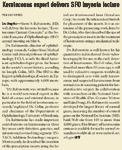Article
Revolutionary changes in IOL technology on the horizon
Better accommodating IOLs are also needed, and ideally, the new technology will be so sophisticated that it allows accommodation to be under the patient's control.

Dr. Lindstrom, adjunct professor emeritus, department of ophthalmology, University of Minnesota, and founder, Minnesota Eye Consultants, Minneapolis, reviewed features of current IOLs as a backdrop to discussing where the implant field is heading. He spoke at the joint annual meeting of the American Academy of Ophthalmology and European Society of Ophthalmology last year.
As a summary, he noted that there are currently monofocal, multifocal, and accommodating IOLs that are nearly equally divided among one-piece and three-piece styles. Most have biconvex, 6-mm, fixed-power spherical optics, are made of UV-absorbing acrylic or silicone, and can be folded or injected through a 3- to 7-mm incision.

Trends in optics Discussing optic characteristics, Dr. Lindstrom said biconvex will continue to be the predominant shape. However, he expects to see 9-mm optics that mimic the size of the natural crystalline lens. To limit the development of capsular opacity, he believes there will be no more optics with a round posterior edge, but rather they will all either have a square posterior edge design or fill the bag.
Regarding materials, current foldable implants are divided about 60:40 between acrylic/acrylic collamer and silicone. That may change, considering the elasticity advantage offered by silicone.
Dr. Lindstrom suggested a "hybrid elastic acrylic" will be developed in the future that will enable placement through ultra-small incisions.
"In European countries where microincision-compatible IOLs are available, the cataract incision size has already fallen to 2 mm. More thin and rod-like lenses are coming and will be available in the United States, preloaded into injectors that can go through a 1- to 2-mm incision," Dr. Lindstrom said.
Just as there are now sunglasses with photochromic lenses, Dr. Lindstrom predicted that IOLs of the future will be made of photochromic materials that can provide the best of all worlds with regard to protecting from UV and blue light during the day, without carrying any functional trade-off in mesopic environments.
"Transmission of blue light to the retina is really desirable for optimal visual function in certain situations, such as when reading in dim light or when an older person is driving at night. During the day, however, and especially in Hawaii, I wear my blue-blocker lenses all the time," Dr. Lindstrom said.
Surface modification to reduce complications may also be a feature of future IOLs. In that regard, the implants may be impregnated with agents that can reduce or even eliminate capsular opacity, cell adhesion, inflammation, and infection. However, Dr. Lindstrom noted that IOLs might also be impregnated with pharmaceuticals able to enhance the endothelium.
"There is evidence that ascorbic acid in the irrigating solution reduces endothelial cell loss by 50%, so why couldn't we incorporate some sustained-release drug delivery system into the IOL to achieve added benefits with respect to preserving the endothelium?" Dr. Lindstrom said.
Newsletter
Don’t miss out—get Ophthalmology Times updates on the latest clinical advancements and expert interviews, straight to your inbox.





